Abstract
From 1 July 1987 to 31 December 1988, a total of 317 animals (91% of which were dogs) were confirmed to have rabies in Hermosillo, Mexico. The median age of rabid dogs was 1 year, 69% were male, and 98% were owned. The epizootic started in the southern areas of the city, rapidly involved the entire city, and persisted mainly in lower socioeconomic status areas. The area of the city and mean household size were significant predictor variables for the population density of rabid dogs around household clusters (Poisson linear regression, P < 0.001 and P = 0.03, resp). Approximately 2.5% of city residents were bitten by dogs in 1987, with the rate of reported dog bite injuries being positively correlated with mean household size and the proportion of households that owned dogs. Visits to the city health centre for evaluation of possible exposures to rabies increased by 135% after the start of the epizootic; approximately 273 per 100,000 city residents were administered a full or partial course of rabies post-exposure prophylaxis in 1987. Children were at greatest risk for exposures to rabies, accounting for 60% of all reported animal bite injuries evaluated at the health centre. Also they were more likely than older persons to have received bite injuries to the head, face, and neck (odds ratio = 21.6, 95% confidence interval = 5.4, 186.5).
Full text
PDF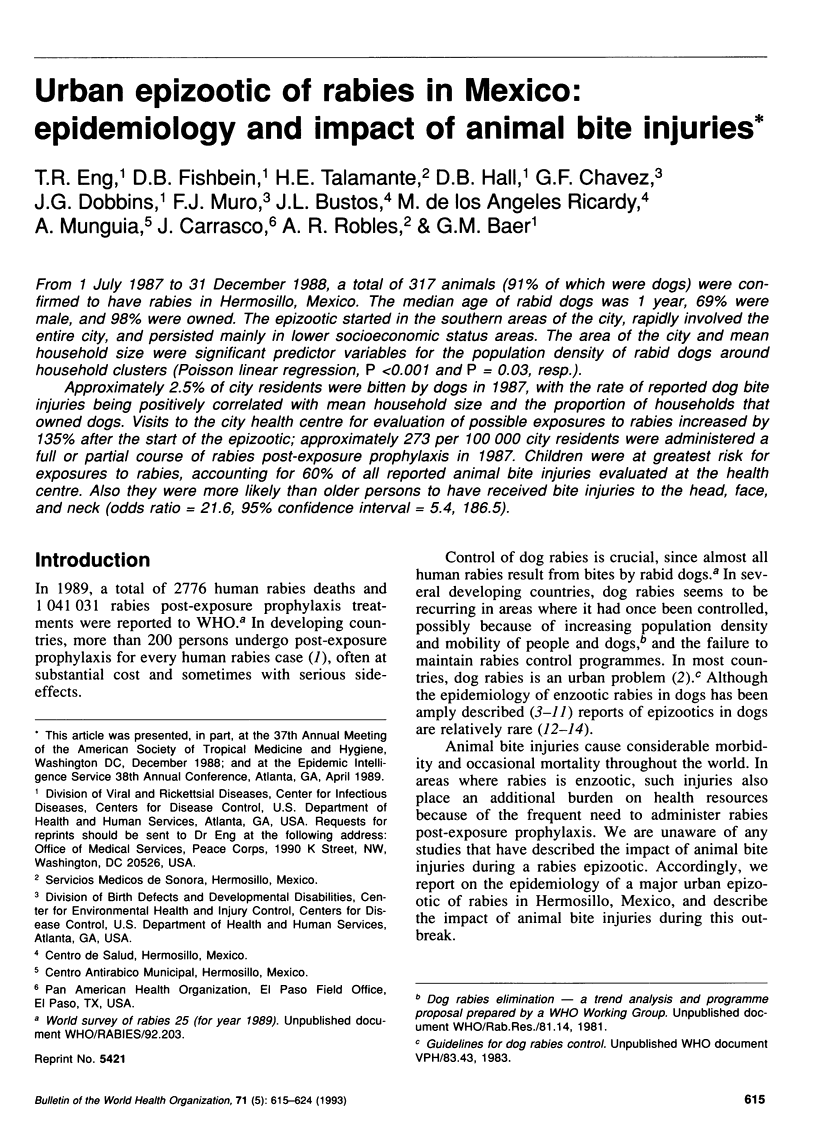
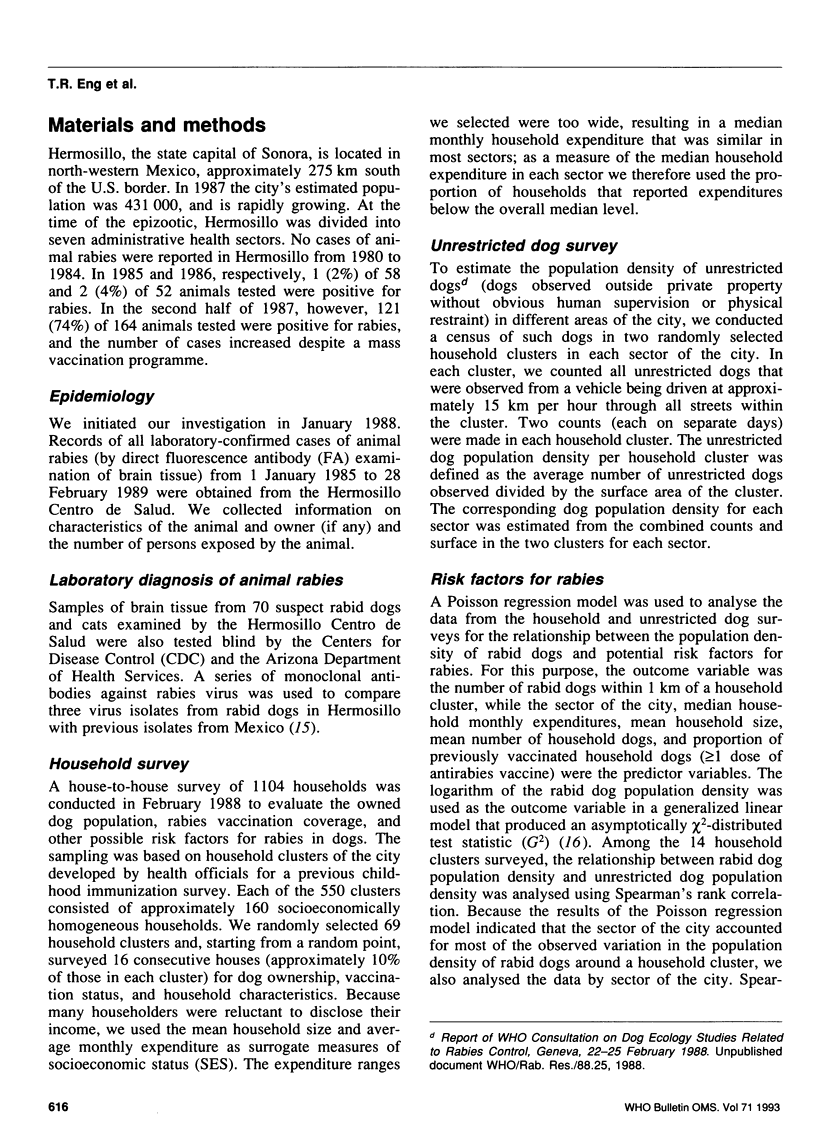
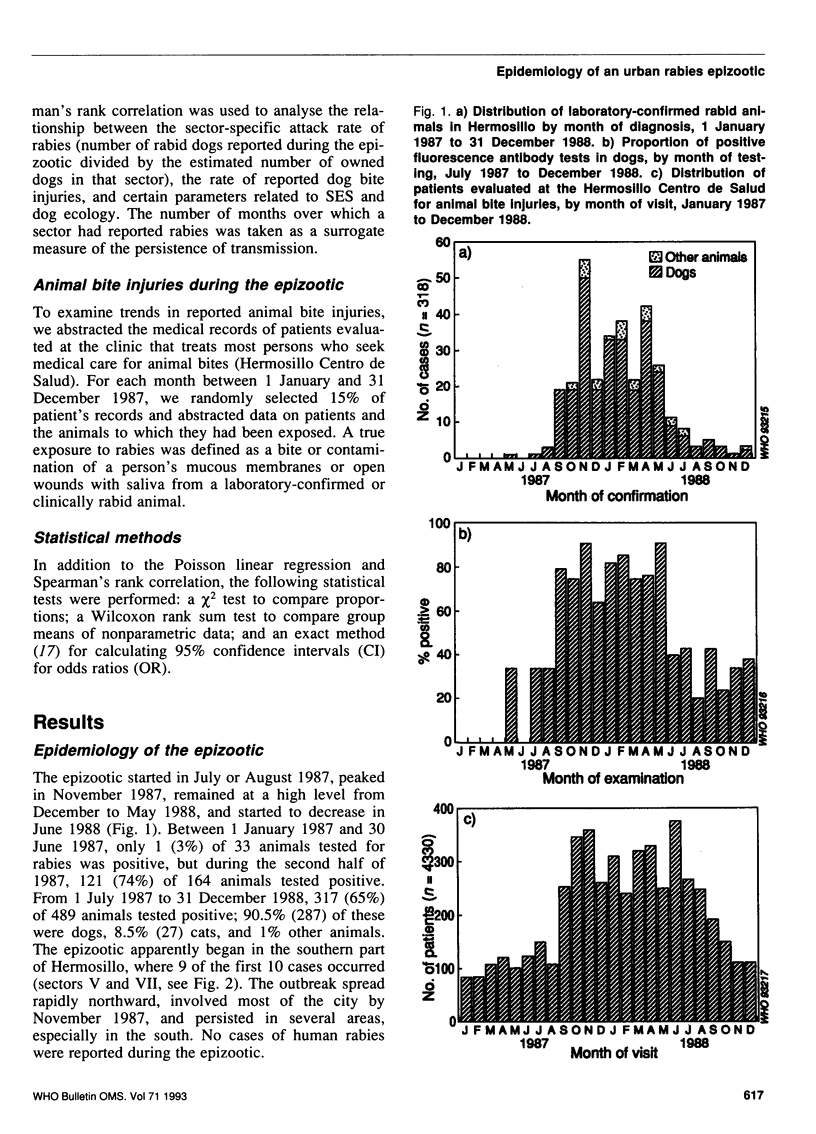
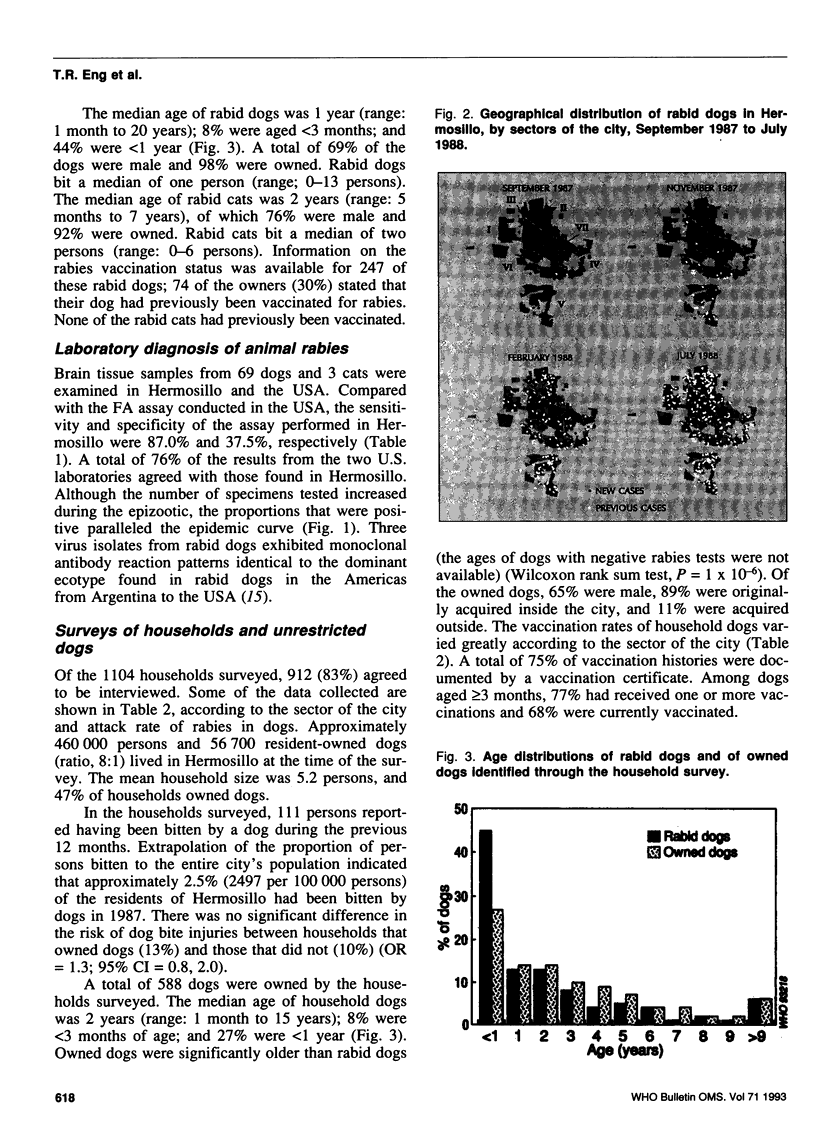
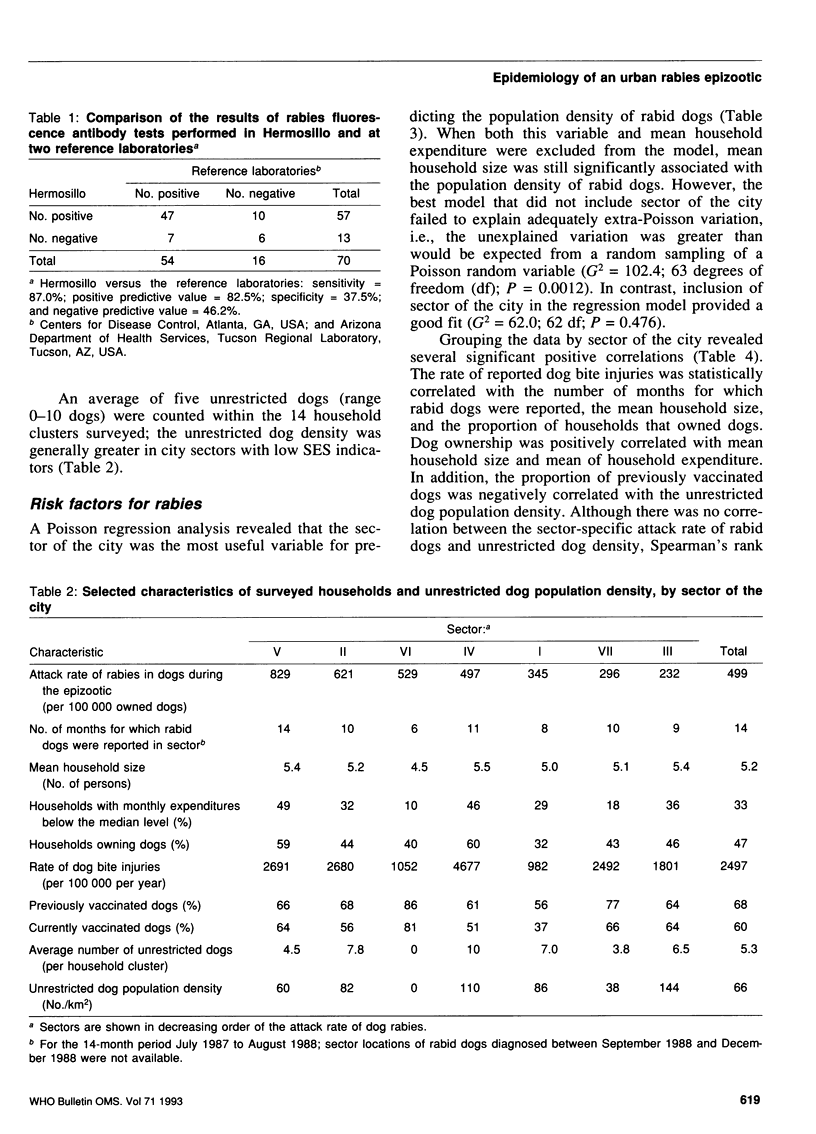
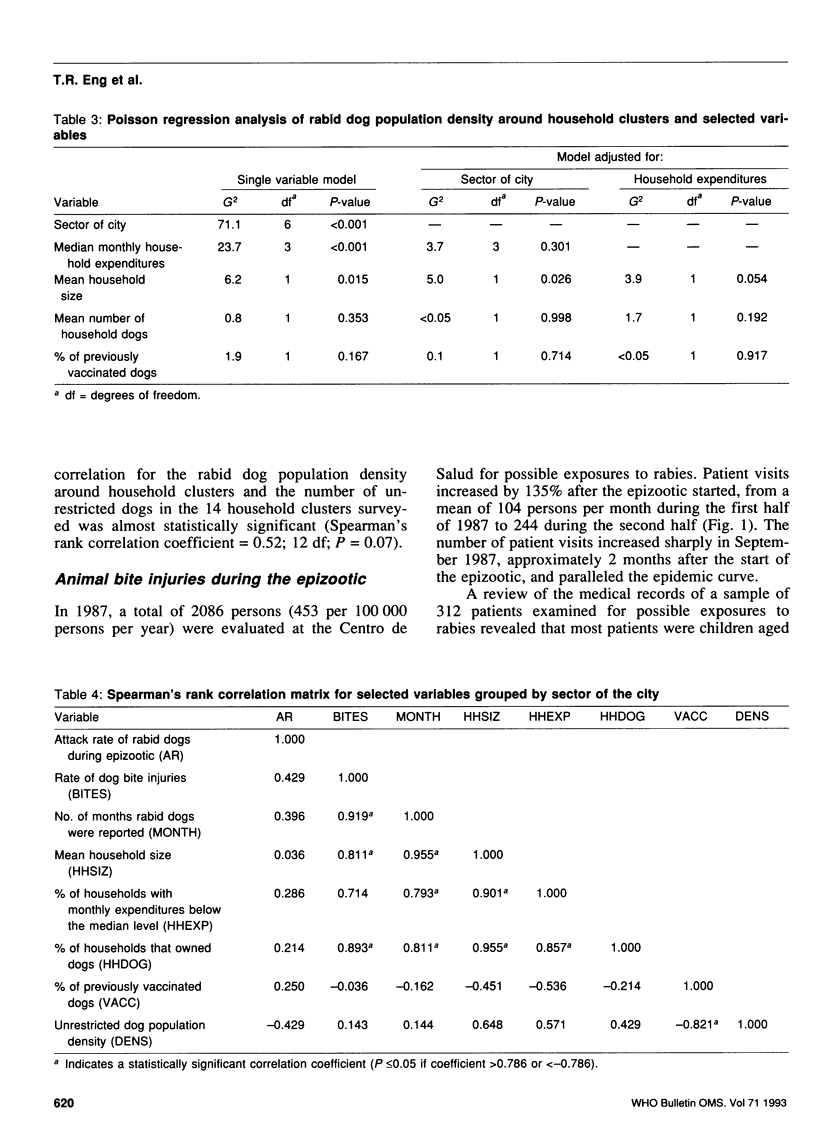



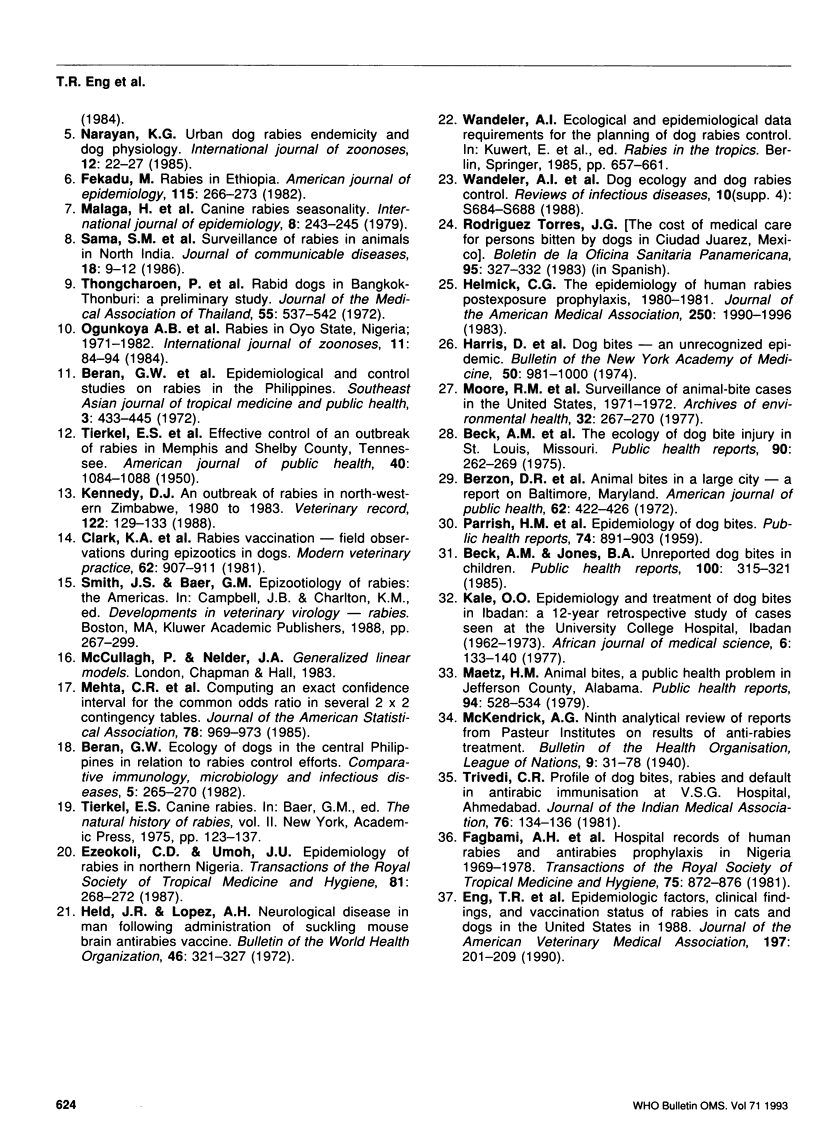
Images in this article
Selected References
These references are in PubMed. This may not be the complete list of references from this article.
- Alonge D. O., Abu S. A. Rabies in Ghana, West Africa. Int J Zoonoses. 1984 Jun;11(1):53–58. [PubMed] [Google Scholar]
- Beck A. M., Jones B. A. Unreported dog bites in children. Public Health Rep. 1985 May-Jun;100(3):315–321. [PMC free article] [PubMed] [Google Scholar]
- Beck A. M., Loring H., Lockwood R. The ecology of dog bite injury in St. Louis, Missouri. Public Health Rep. 1975 May-Jun;90(3):262–267. [PMC free article] [PubMed] [Google Scholar]
- Belcher D. W., Wurapa F. K., Atuora D. O. Endemic rabies in Ghana. Epidemiology and control measures. Am J Trop Med Hyg. 1976 Sep;25(5):724–729. doi: 10.4269/ajtmh.1976.25.724. [DOI] [PubMed] [Google Scholar]
- Beran G. W. Ecology of dogs in the Central Philippines in relation to rabies control efforts. Comp Immunol Microbiol Infect Dis. 1982;5(1-3):265–270. doi: 10.1016/0147-9571(82)90047-9. [DOI] [PubMed] [Google Scholar]
- Beran G. W., Nocete A. P., Elviña O., Gregorio S. B., Moreno R. R., Nakao J. C., Burchett G. A., Cañizares H. L., Macasaet F. F. Epidemiological and control studies on rabies in the Philippines. Southeast Asian J Trop Med Public Health. 1972 Sep;3(3):433–445. [PubMed] [Google Scholar]
- Berzon D. R., Farber R. E., Gordon J., Kelley E. B. Animal bites in a large city--a report on Baltimore, Maryland. Am J Public Health. 1972 Mar;62(3):422–426. doi: 10.2105/ajph.62.3.422. [DOI] [PMC free article] [PubMed] [Google Scholar]
- Bögel K., Motschwiller E. Incidence of rabies and post-exposure treatment in developing countries. Bull World Health Organ. 1986;64(6):883–887. [PMC free article] [PubMed] [Google Scholar]
- Clark K. A., Kelly V. P., Newman E. C., Bilderback W. R., Nettles W. D., Rhodes T. S. Rabies vaccination: field observations during epizootics in dogs. Mod Vet Pract. 1981 Dec;62(12):907–911. [PubMed] [Google Scholar]
- Eng T. R., Fishbein D. B. Epidemiologic factors, clinical findings, and vaccination status of rabies in cats and dogs in the United States in 1988. National Study Group on Rabies. J Am Vet Med Assoc. 1990 Jul 15;197(2):201–209. [PubMed] [Google Scholar]
- Escobar Cifuentes E. Program for the elimination of urban rabies in Latin America. Rev Infect Dis. 1988 Nov-Dec;10 (Suppl 4):S689–S692. doi: 10.1093/clinids/10.supplement_4.s689. [DOI] [PubMed] [Google Scholar]
- Ezeokoli C. D., Umoh J. U. Epidemiology of rabies in northern Nigeria. Trans R Soc Trop Med Hyg. 1987;81(2):268–272. doi: 10.1016/0035-9203(87)90237-9. [DOI] [PubMed] [Google Scholar]
- Fagbami A. H., Anosa V. O., Ezebuiro E. O. Hospital records of human rabies and antirabies prophylaxis in Nigeria 1969-78. Trans R Soc Trop Med Hyg. 1981;75(6):872–876. doi: 10.1016/0035-9203(81)90436-3. [DOI] [PubMed] [Google Scholar]
- Fekadu M. Rabies in Ethiopia. Am J Epidemiol. 1982 Feb;115(2):266–273. doi: 10.1093/oxfordjournals.aje.a113298. [DOI] [PubMed] [Google Scholar]
- Held J. R., Adaros H. L. Neurological disease in man following administration of suckling mouse brain antirabies vaccine. Bull World Health Organ. 1972;46(3):321–327. [PMC free article] [PubMed] [Google Scholar]
- Helmick C. G. The epidemiology of human rabies postexposure prophylaxis, 1980-1981. JAMA. 1983 Oct 21;250(15):1990–1996. [PubMed] [Google Scholar]
- Kale O. O. Epidemiology and treatment of dog bites in Ibadan: a 12-year retrospective study of cases seen at the University College Hospital Ibadan (1962-1973). Afr J Med Med Sci. 1977 Sep;6(3):133–140. [PubMed] [Google Scholar]
- Kennedy D. J. An outbreak of rabies in north-western Zimbabwe 1980 to 1983. Vet Rec. 1988 Feb 6;122(6):129–133. doi: 10.1136/vr.122.6.129. [DOI] [PubMed] [Google Scholar]
- Maetz H. M. Animal bites, a public health problem in Jefferson County, Alabama. Public Health Rep. 1979 Nov-Dec;94(6):528–534. [PMC free article] [PubMed] [Google Scholar]
- Malaga H., Lopez Nieto E., Gambirazio C. Canine rabies seasonality. Int J Epidemiol. 1979 Sep;8(3):243–245. doi: 10.1093/ije/8.3.243. [DOI] [PubMed] [Google Scholar]
- Moore R. M., Jr, Zehmer R. B., Moulthrop J. I., Parker R. L. Surveillance of animal-bite cases in the United States, 1971-1972. Arch Environ Health. 1977 Nov-Dec;32(6):267–270. doi: 10.1080/00039896.1977.10667293. [DOI] [PubMed] [Google Scholar]
- Narayan K. G. Urban dog rabies endemicity and dog physiology. Int J Zoonoses. 1985 Mar;12(1):22–27. [PubMed] [Google Scholar]
- Ogunkoya A. B., Will L. A., Ezeokoli C. D. Rabies in Oyo State, Nigeria; 1971-1982. Int J Zoonoses. 1984 Jun;11(1):84–94. [PubMed] [Google Scholar]
- PARRISH H. M., CLACK F. B., BROBST D., MOCK J. F. Epidemiology of dog bites. Public Health Rep. 1959 Oct;74:891–903. [PMC free article] [PubMed] [Google Scholar]
- Rodríguez Torres J. G., Cuellar A. M., Rauda Esquivel J. Costo de la atención a personas mordidas por perros en Ciudad Juárez, México. Bol Oficina Sanit Panam. 1983 Oct;95(4):327–332. [PubMed] [Google Scholar]
- Sama S. M., Sharma S. B., Saxena S. N. Surveillance of rabies in animals in North India. J Commun Dis. 1986 Mar;18(1):9–12. [PubMed] [Google Scholar]
- TIERKEL E. S., GRAVES L. M., TUGGLE H. G., WADLEY S. L. Effective control of an outbreak of rabies in Memphis and Shelby County, Tennessee. Am J Public Health Nations Health. 1950 Sep;40(9):1084–1088. doi: 10.2105/ajph.40.9.1084. [DOI] [PMC free article] [PubMed] [Google Scholar]
- Thongcharoen P., Charoenrath M., Panpatana P., Wasi C. Rabid dogs in Bangkok--Thonburi. A preliminary study. J Med Assoc Thai. 1972 Sep;55(9):537–542. [PubMed] [Google Scholar]
- Trivedi C. R. Profile of dog bites, rabies and default in antirabies immunisation at V.S.G. Hospital, Ahmedabad. J Indian Med Assoc. 1981 Apr;76(7-8):134–136. [PubMed] [Google Scholar]
- Wandeler A. I., Budde A., Capt S., Kappeler A., Matter H. Dog ecology and dog rabies control. Rev Infect Dis. 1988 Nov-Dec;10 (Suppl 4):S684–S688. doi: 10.1093/clinids/10.supplement_4.s684. [DOI] [PubMed] [Google Scholar]



